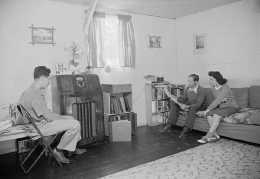Printable Version
| Japanese-American Internment |
Previous |
Next |
Digital History ID 3495
|
 The Immigration Act of 1924 barred the Japanese from migrating to the United States. Consequently, the Japanese comprised a tiny portion of the population in 1941--totaling no more than 260,000 people. Of this number, 150,000 lived in Hawaii. The remaining 110,000 Japanese concentrated on the West Coast where they worked mostly as small farmers or business-people serving the Japanese community. After Pearl Harbor, rumors spread about Japanese troops preparing to land in California. Allegedly, they planned to link-up with Japanese Americans and Japanese aliens poised to strike as a fifth column for the invasion.
The Immigration Act of 1924 barred the Japanese from migrating to the United States. Consequently, the Japanese comprised a tiny portion of the population in 1941--totaling no more than 260,000 people. Of this number, 150,000 lived in Hawaii. The remaining 110,000 Japanese concentrated on the West Coast where they worked mostly as small farmers or business-people serving the Japanese community. After Pearl Harbor, rumors spread about Japanese troops preparing to land in California. Allegedly, they planned to link-up with Japanese Americans and Japanese aliens poised to strike as a fifth column for the invasion.
On February 19, 1942, Roosevelt authorized the Department of War to designate military areas and to exclude any or all persons from them. Armed with this power, military authorities immediately moved against Japanese aliens. In Hawaii, the military did not force Japanese Americans to relocate because a large portion of the population was of Japanese ancestry and the local economy depended on their labor. On the West Coast, however, military authorities ordered the Japanese to leave, drawing no distinction between aliens and citizens. Forced to sell their property for pennies on the dollar, most Japanese Americans suffered severe financial losses. Relocation proved next to impossible as no other states would take them. The governor of Idaho opposed any migration, declaring: "The Japs live like rats, breed like rats and act like rats. We don't want them."
Roosevelt created the War Relocation Authority when voluntary measures failed. It resettled 100,000 Japanese Americans in ten isolated internment camps scattered across seven western states. Called relocation camps, they resembled minimum security prisons. In these concentration camps, American citizens who had committed no crimes were locked behind barbed wire and crowded into ramshackle wooden barracks. The families lived one family to a room that was furnished with nothing but cots and bare light bulbs. They were forced to endure bad food, inadequate medical care, and poorly equipped schools.
Nearly 18,000 Japanese American men won release from those camps to fight for the United States Army. Most served with the 100th Infantry Battalion and the 442nd Regimental Combat Team. In Italy, the 442nd sustained nearly 10,000 casualties, with 3,600 Purple Hearts, 810 Bronze Stars, 342 Silver Stars, 123 divisional citations, 47 Distinguished Service Crosses, 17 Legions of Merit, 7 Presidential Unit Citations, and 1 Congressional Medal of Honor. In short, they fought heroically, emerging as the most decorated military unit in World War II. In one of the most painful scenes in American history, Japanese American parents, still locked inside concentration camps, received posthumous Purple Hearts for their sons.
Japanese Americans protested their treatment in court. Citing national security considerations, the Supreme Court upheld the internment order by a six to three vote in the case, Korematsu v. U.S. (1944). In a dissenting opinion, however, Frank Murphy admitted that federal policy had fallen "into the ugly abyss of racism." On December 18, 1944, in the Endo case, the Supreme Court ruled that a civilian agency (the War Relocation Authority) had no right to incarcerate law-abiding citizens. Two weeks later, the federal government began closing down the camps, ending one of the most shameful chapters in American history.
Copyright 2021 Digital History
|
